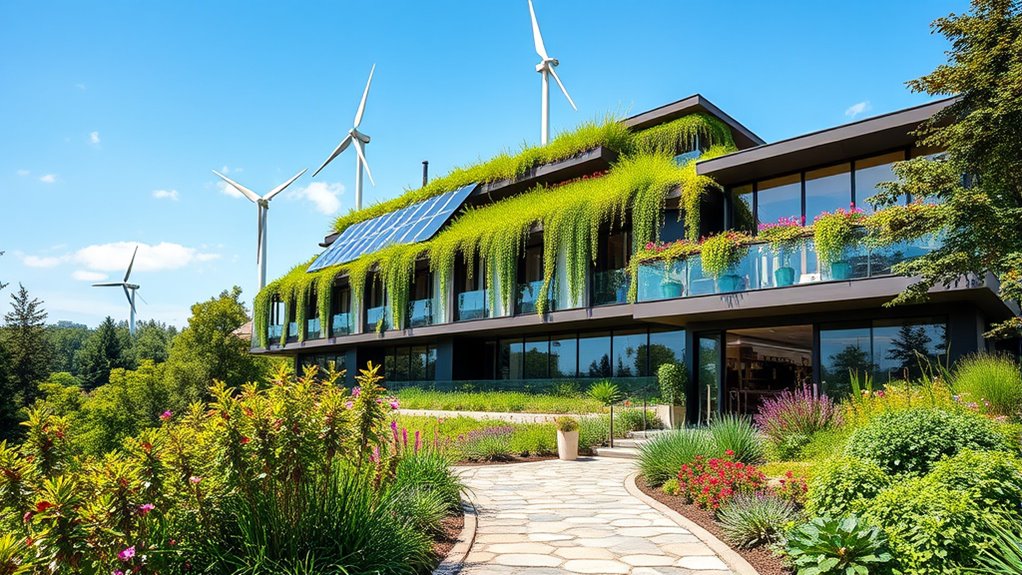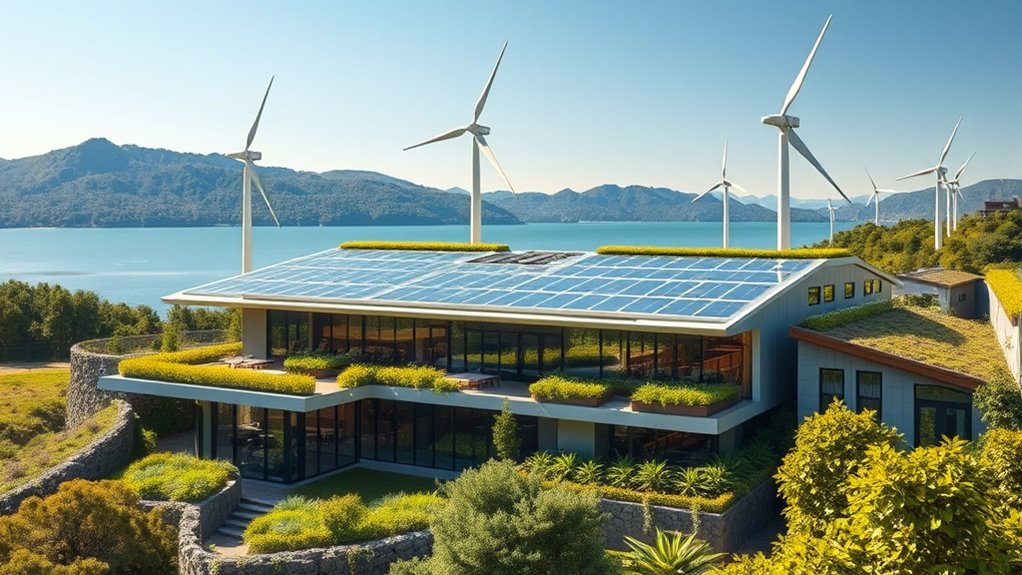Carbon-neutral hotels lead in sustainability by cutting their environmental impact through renewable energy, efficient water and waste practices, and eco-friendly materials. They often pursue certifications like Green Key or ISO 14001 to prove their commitment, while supporting local communities with sustainable sourcing and programs. Innovative technologies like solar panels and EV charging stations help reduce emissions further. If you want to discover how these hotels set new standards in eco-conscious hospitality, explore the innovative practices shaping their future.
Key Takeaways
- Carbon-neutral hotels achieve net-zero emissions through renewable energy, energy efficiency, and carbon offset programs.
- They adopt sustainable building materials and eco-friendly designs to minimize environmental impact.
- Certification standards like Green Globe and ISO 14001 verify their commitment to sustainability.
- Community engagement and local sourcing support social and economic development while reducing carbon footprints.
- Future-focused strategies include climate resilience planning and promoting eco-friendly transportation options.

Have you ever wondered how hotels are reducing their environmental impact while still offering comfort and luxury? The answer lies in the rise of carbon-neutral hotels, which are leading the way in sustainable tourism. These hotels pursue certifications like Green Globe, EU Ecolabel, Green Key, ISO 14001, and GSTC, each emphasizing different aspects of environmental, social, and economic responsibility. Earning these credentials means the hotel adheres to strict standards that promote eco-friendly practices while maintaining high-quality guest experiences.
To achieve carbon neutrality, these hotels implement a variety of sustainability practices. They focus on energy efficiency by adopting renewable sources such as solar and wind power, which drastically cut down on greenhouse gas emissions. You’ll notice many hotels installing solar panels or wind turbines, turning to innovative technologies to reduce their reliance on fossil fuels. Water conservation is another priority, with low-flow fixtures and smart water management systems helping to minimize water usage without sacrificing guest comfort. Waste management practices, including recycling and composting, further reduce the environmental footprint of operations, ensuring that waste is minimized and responsibly handled. Hotels also monitor their emissions carefully, which helps them identify key areas for improvement and track progress toward their sustainability goals. Additionally, they often utilize energy-efficient appliances and lighting systems to further decrease their energy consumption. Many of these hotels also employ sustainable building materials to reduce their environmental impact from construction and renovation activities. Incorporating eco-friendly design principles enhances their commitment to environmental stewardship and promotes a healthier indoor environment for guests and staff alike. Implementing sustainable practices also often involves staff training and guest engagement to foster a culture of sustainability throughout the property.
Supporting local communities is a core element of these hotels’ sustainability efforts. They actively engage in initiatives that promote social and economic development, such as sourcing local food and crafts, supporting local employment, and preserving cultural heritage. Utilizing eco-friendly materials in construction and daily operations also plays a significant role, ensuring that resources are sustainably sourced and environmentally benign. Community involvement helps strengthen local relationships and enriches the guest experience by emphasizing authentic cultural connections. Moreover, these hotels often collaborate with local organizations to develop long-term community projects that align with their sustainability goals.
Many carbon-neutral hotels set ambitious targets for emission reductions and actively pursue renewable energy solutions. They invest in renewable power and participate in carbon offset programs to compensate for emissions that are difficult to eliminate directly. This might include planting trees or investing in clean energy projects elsewhere. Additionally, these hotels offer eco-friendly transportation options for guests, like electric vehicle charging stations or partnering with sustainable transit providers, helping to reduce carbon footprints even further. Climate resilience planning ensures that they are prepared for future climate impacts, safeguarding their operations and local communities.
Beyond the environmental benefits, embracing sustainability delivers economic advantages. These hotels often experience lower operating costs due to reduced energy and water consumption, while also attracting a growing segment of eco-conscious travelers. Compliance with environmental regulations is easier, and staff engagement in sustainability initiatives boosts morale and retention. They also open doors to new investment opportunities in green technologies and sustainable practices.
Socially, carbon-neutral hotels foster strong community ties by supporting local initiatives, preserving cultural traditions, and promoting environmental education. They champion fair labor practices and participate in charitable activities that benefit the communities they serve. Implementing environmental management systems like ISO 14001 ensures ongoing compliance and continuous improvement, cementing their commitment to sustainability. Ultimately, these hotels demonstrate that luxury and environmental responsibility can go hand in hand, setting a powerful example for the future of travel.
Frequently Asked Questions
How Do Carbon-Neutral Hotels Offset Their Remaining Emissions?
You might wonder how hotels offset their remaining emissions. They purchase high-quality, verified carbon credits from reputable projects like renewable energy or forestry initiatives. By retiring these credits transparently, they guarantee their emissions are effectively counterbalanced. This process supports global climate efforts, helps hotels meet their sustainability goals, and reassures guests that their stay contributes to reducing overall carbon impact.
What Certifications Verify a Hotel’s Carbon-Neutral Status?
Ever wonder how you can prove a hotel’s commitment to sustainability? Certifications like the CarbonNeutral Protocol, which verifies compliance with strict technical standards, and the EDGE Certification for zero carbon buildings, serve as your proof. Regional standards like Green Globe or LEED also validate eco-friendly practices. These certifications act as badges of honor, showing that the hotel’s efforts truly match its green promises.
Are There Additional Costs for Guests at Carbon-Neutral Hotels?
You might wonder if staying at a carbon-neutral hotel costs extra. Usually, it doesn’t. Hotels absorb the carbon offset costs, which typically range from $10 to $12 per square meter annually, without passing them to you. Some eco-luxury hotels include sustainability in their room rates, but they don’t charge extra for it. Overall, your experience remains the same, with eco-friendly features and amenities often included at no additional cost.
How Do These Hotels Measure and Report Their Sustainability Progress?
You might wonder how hotels track their sustainability progress. They use tools like the Hotel Carbon Measurement Initiative (HCMI) to calculate their carbon footprint and monitor energy use. Hotels set reduction targets, incorporate renewable energy, and track key metrics through sustainability reporting standards. They also engage stakeholders, compare industry benchmarks, and constantly improve operational practices. Regular reports ensure transparency, accountability, and demonstrate their commitment to reducing environmental impact.
Can Small Hotels Realistically Achieve Carbon Neutrality?
Can small hotels realistically achieve carbon neutrality? Absolutely, yes. Like a small boat steering through vast waters, they can steer toward sustainability by adopting energy-efficient technologies, using renewable energy, and implementing smart systems. Though challenges exist, strategic planning and incremental steps make it feasible. With commitment, they can reduce emissions, cut costs, and contribute meaningfully to global efforts—proving that size doesn’t limit sustainability possibilities.
Conclusion
By choosing carbon-neutral hotels, you’re not just booking a stay—you’re joining a movement toward sustainability. As you embrace eco-friendly practices, remember even Leonardo da Vinci would be impressed by how modern innovation meets ancient wisdom in protecting our planet. Every stay helps reduce carbon footprints and paves the way for a greener future. So, next time you travel, think of yourself as a pioneer, forging a path toward a more sustainable world—no DeLorean required.









